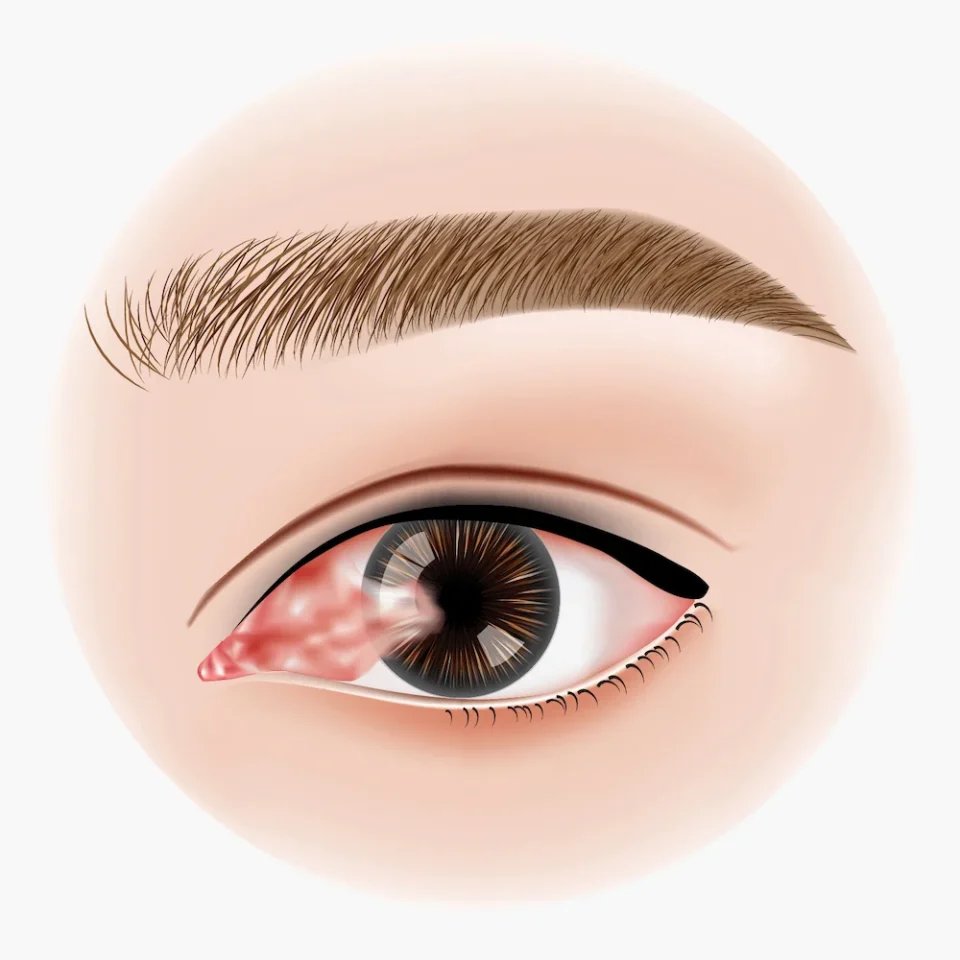
Pterygium is a condition that shows up as a growth on the white part of your eyeball, called the sclera. The bump is elevated and shaped like a wedge. Pterygium is colloquially called surfer’s eye because the most common cause of the condition is glare from the sun that’s multiplied when you’re on the water.
Pterygium usually isn’t cancerous, but it can cause disfigurement. The white bumps also can lead to blurry vision and pain. If the pterygium is small enough and not causing you any major discomfort, your ophthalmologist may just treat it with lubricating drops and keep a close watch on its progression. If, however, it begins to affect your vision, appearance or comfort, pterygium surgery may be the best option.
All symptoms, potential procedural/surgical options should always be discussed with your physician after a thorough consultation and examination for an accurate diagnosis and treatment plan.

Surgical Advancements
Previously, the surgery used to remove pterygium was called bare sclera because it left the whites of your eye open to reoccurrences. Regrowth used to occur in more than 50 percent of patients and very often the regrowth was bigger than the original bump. The latest techniques have reduced the rate of reoccurrence to anywhere from five to 40 percent, depending on how well you take care of your eyes following the pterygium surgery procedure.
Talk to your ophthalmologist about the various modern options available for surgery that have a much better chance of preventing regrowth or of doing even more damage to your eye. Most surgeries to remove pterygium typically take no more than about 30 minutes. The procedure is performed on an out-patient basis in your ophthalmologist’s office. You’re lightly sedated to help you relax, and your eye is totally numbed before the surgery. You won’t be able to see during the procedure.
Stitches or No Stitches
Once the pterygium is removed, you don’t have the protection of the mucus membrane anymore. Your eye surgeon chooses one of two ways to attach a thin layer of skin taken from your upper eyelid to cover up the spot where the bump was located:
- Tiny stitches may be used to hold the new skin in place. They dissolve within about two weeks but can be disconcerting and uncomfortable while they’re still present.
- No-stick pterygium surgery requires less downtime and is far less painful. It relies on a special kind of glue to hold the new skin in place. This latest technique also reduces surgery time from 30 to closer to 15 minutes.
- While stitches have been the gold standard in treating surfer’s eye and are more reliable, the glue used for the pterygium surgery is very expensive and sometimes difficult to obtain. At the same time, for cosmetic reasons, the best outcome usually occurs when no stitches are used.
A third approach, according to the American Academy of Ophthalmology, uses no stitches and no glue. Instead, the surgeon allows a small amount of blood to pool in your eye, over which he lays the new skin. By holding the skin in place with sutures for three to five minutes, the skin automatically attaches itself to your eye.

Possible Complications
Though rare, you need to know that it’s possible that the surgical removal of the pterygium can lead to vision complications. Astigmatism, for example, is one of the most common side effects of the pterygium surgery.
While you run the risk of losing the skin graft after any of the procedures, the no-stitch and blood-adhesive approaches pose the greatest risk of the graft coming loose. Also, if you are taking any blood thinners or have any kind of coagulating disorder, you’re not a candidate for the procedure that relies on your blood to hold the new graft securely.
What To Expect Immediately Following Surgery
You may feel some mild discomfort following the pterygium surgery. Your doctor may or may not prescribe pain medication; usually, over-the-counter pain relievers are sufficient. You’ll most likely need to wear an eyepatch for at least a couple days to make sure no debris gets in the incision and to protect your sensitive eye from further damage.
It’s advised that you rest for a couple days and avoid any strenuous activity. Particularly stay away from tasks that could put pressure on your eye. Keep your head elevated as much as possible to avoid bleeding. Normally, you’re able to return to work and your regular activities within a day or two.
After Surgery Care
To help with wound healing and to reduce the scarring that you might get from the pterygium surgery, your doctor may prescribe a topical medication such as mitomycin C. It can be applied after the excision, and you can continue to use it as you recuperate to prevent further occurrences of surfer’s eye.
Following pterygium surgery, you may also be advised to use steroid drops for at least two weeks to prevent swelling and avoid regrowth. One of the most important steps you can take to aid in the healing process and greatly decrease the chances of reoccurrence is to wear sunglasses with effective UV protection.

Damage Prevention
Ideally, you should purchase sunglasses that provide 99 to 100 percent UV coverage from UVA and UVB sunlight. UVA rays can pass through clear glass and cause as much damage as UVB rays. Both are directly related to cancer and surfer’s eye.
The best protective eyewear that you can get is labeled “UV 400” because they will block all the wavelengths up to 400 nanometers as well as block all damaging and benign sunrays. Consider wearing a pair of wraparound sunglasses to keep out the rays that can sneak in through the sides of the frames. If you’re an actual surfer (or any other kind of athlete), wear UV 400 level protective sunglasses for your sport. They’re typically made of shatterproof lenses that give you added protection for your eyes.
Sometimes, pterygium returns, even after you’ve had the bump surgically removed — no matter which kind of surgery you had. And this is almost always due to repeated sun exposure to the harmful ultraviolet rays that cause the condition in the first place. Another factor, as with any surgery, is the experience and competency of your ophthalmologist. It’s vital that you seek an eye doctor with impeccable credentials and extensive experience to perform surgery on your eye.
All symptoms, potential procedural/surgical options should always be discussed with your physician after a thorough consultation and examination for an accurate diagnosis and treatment plan.
Important Reminder: This information is only intended to provide guidance, not a definitive medical advice. Please consult your eye doctor about your specific condition. Only a trained, experienced board certified eye doctor can determine an accurate diagnosis and proper treatment.

Contact Southern Eye Group
Do you have any questions about Pterygium Surgery treatment? Contact us to schedule an appointment with one of our Southern Eye Group specialists today.
The doctors at Southern Eye Group have either authored or reviewed and approved this content.
Page Updated:


